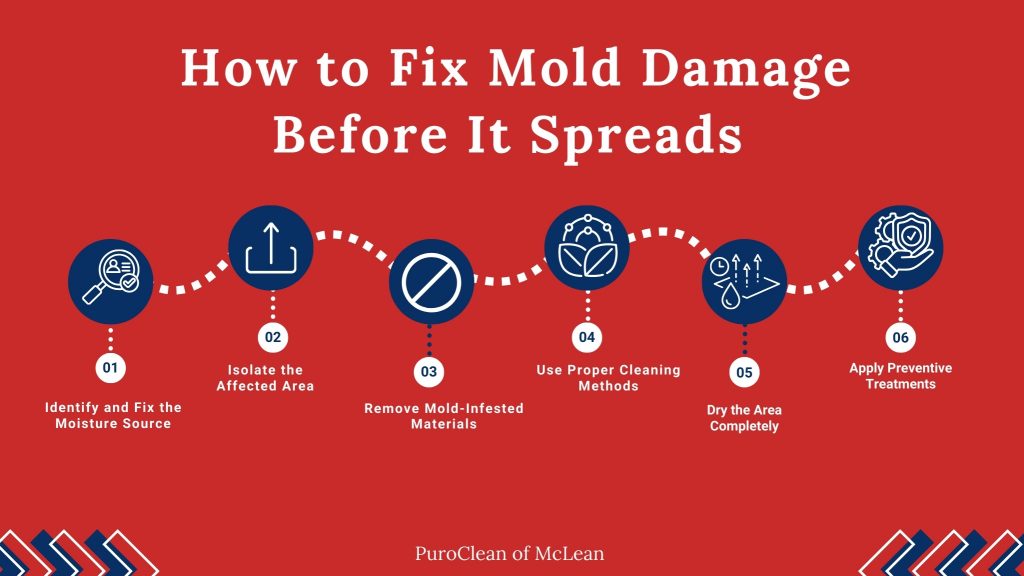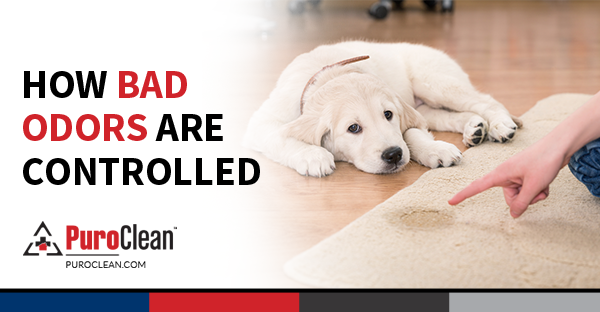Mold damage is a serious issue that can silently spread throughout your home, leading to structural problems and health risks. It thrives in damp, humid environments and often goes unnoticed until it becomes a major problem. Identifying mold early and taking swift action can help fix mold damage before it worsens, preventing costly repairs and potential health hazards.
In this guide, we’ll discuss how to recognize mold damage, effective ways to remove black mold, and why professional mold cleanup is essential for complete restoration.
Signs of Mold Damage in Your Home
Mold growth can start in hidden areas such as behind walls, under flooring, or in attics and basements. Knowing the warning signs can help you take action before the problem worsens.
- Musty Odor
One of the first indicators of mold damage is a strong, musty smell. If you notice an earthy odor in specific areas of your home, especially in damp or poorly ventilated spaces, mold could be present.
- Visible Mold Growth
Mold appears in various colors, including black, green, white, and yellow. It often starts as small spots but can quickly spread across walls, ceilings, and furniture.
- Water Damage or Stains
Discolored patches on walls, ceilings, or floors can indicate moisture problems, which often lead to mold damage. Peeling paint, bubbling wallpaper, or warped surfaces are also common warning signs.
- Increased Allergy Symptoms
If you or your family experience frequent allergy symptoms such as sneezing, coughing, itchy eyes, or respiratory issues, mold spores in the air could be the cause.
- Condensation and High Humidity
Excess moisture from condensation on windows, pipes, or walls can create the perfect environment for mold to thrive. Controlling humidity levels is key to preventing mold growth.
How to Fix Mold Damage Before It Spreads
Once mold damage is detected, immediate action is necessary to stop it from spreading. Here’s how you can effectively handle mold issues in your home:
- Identify and Fix the Moisture Source
Mold cannot grow without moisture. To successfully remove mold, you must address the underlying cause, such as:
- Leaking pipes or roofs
- Poor ventilation in bathrooms and kitchens
- Flooding or water damage
- Isolate the Affected Area
To prevent mold spores from spreading, close off the contaminated area using plastic sheets and tape. This is particularly important during mold cleanup to contain the spores.
- Remove Mold-Infested Materials
Porous materials like drywall, carpeting, and insulation that have been severely affected by mold damage may need to be removed and replaced. Hard surfaces such as glass, tile, and metal can often be cleaned and disinfected.
- Use Proper Cleaning Methods
For small mold problems, a mixture of water and detergent or vinegar can sometimes be effective. However, extensive mold infestations require professional-grade cleaning solutions.
- Avoid using bleach, as it only removes surface mold without killing spores.
- Use HEPA vacuums and air scrubbers to remove airborne mold spores.
- Dry the Area Completely
After mold cleanup, drying the affected area is crucial. Mold thrives in moisture, so using dehumidifiers, fans, and proper ventilation helps prevent regrowth.
- Apply Preventive Treatments
Once the area is dry, applying antimicrobial treatments or mold-resistant paint can help stop future mold growth.

Why Professional Mold Cleanup is Necessary
While DIY methods may seem like a cost-effective solution, professional mold cleanup ensures thorough removal and prevention. Here’s why hiring experts is the best choice:
- Advanced Mold Detection
Professional mold cleanup specialists use infrared cameras and moisture meters to detect mold growth hidden behind walls and under floors.
- Safe and Effective Removal
Mold spores can spread easily if not handled properly. Professionals use HEPA filtration systems and containment strategies to remove mold damage safely.
- Complete Moisture Control
Experts not only clean the mold but also identify and fix moisture issues, ensuring the problem doesn’t return.
- Better Air Quality
Mold spores can linger in the air even after visible mold is removed. Professional mold cleanup improves indoor air quality by using industrial-grade air purifiers.
- Prevent Structural Damage
Severe mold damage can weaken wood, drywall, and insulation. Professionals assess and restore structural integrity, preventing costly repairs.
Preventing Mold Damage in the Future
Taking preventive measures can help protect your home from future mold issues. Follow these steps to reduce the risk of mold damage:
- Control Humidity Levels – Keep indoor humidity below 50% using dehumidifiers.
- Improve Ventilation – Use exhaust fans in bathrooms and kitchens to reduce moisture buildup.
- Fix Leaks Immediately – Repair any leaks in your plumbing, roof, or basement to prevent water damage.
- Use Mold-Resistant Materials – Consider mold-resistant drywall and paints in moisture-prone areas.
- Regular Inspections – Check your home regularly for signs of moisture problems and mold damage.
Protect Your Home with Expert Mold Cleanup from PuroClean of McLean
Mold damage can escalate quickly, affecting both your property and your health. The sooner you take action, the easier it is to prevent further damage and costly repairs. At PuroClean of McLean, we specialize in professional mold cleanup, using advanced techniques to detect, remove, and prevent mold growth.
Don’t let mold take over your home; trust our experts to restore your space safely and efficiently.



